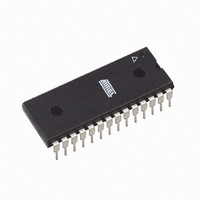ATMEGA8L-8PU Atmel, ATMEGA8L-8PU Datasheet - Page 118

ATMEGA8L-8PU
Manufacturer Part Number
ATMEGA8L-8PU
Description
IC AVR MCU 8K 8MHZ 3V 28DIP
Manufacturer
Atmel
Series
AVR® ATmegar
Datasheets
1.ATMEGA8L-8MU.pdf
(25 pages)
2.ATMEGA8L-8MU.pdf
(302 pages)
3.ATMEGA8-16PU.pdf
(305 pages)
Specifications of ATMEGA8L-8PU
Core Processor
AVR
Core Size
8-Bit
Speed
8MHz
Connectivity
I²C, SPI, UART/USART
Peripherals
Brown-out Detect/Reset, POR, PWM, WDT
Number Of I /o
23
Program Memory Size
8KB (4K x 16)
Program Memory Type
FLASH
Eeprom Size
512 x 8
Ram Size
1K x 8
Voltage - Supply (vcc/vdd)
2.7 V ~ 5.5 V
Data Converters
A/D 6x10b
Oscillator Type
Internal
Operating Temperature
-40°C ~ 85°C
Package / Case
28-DIP (0.300", 7.62mm)
Cpu Family
ATmega
Device Core
AVR
Device Core Size
8b
Frequency (max)
8MHz
Interface Type
SPI/TWI/USART
Total Internal Ram Size
1KB
# I/os (max)
23
Number Of Timers - General Purpose
3
Operating Supply Voltage (typ)
3.3/5V
Operating Supply Voltage (max)
5.5V
Operating Supply Voltage (min)
2.7V
On-chip Adc
6-chx10-bit
Instruction Set Architecture
RISC
Operating Temp Range
-40C to 85C
Operating Temperature Classification
Industrial
Mounting
Through Hole
Pin Count
28
Package Type
PDIP
Processor Series
ATMEGA8x
Core
AVR8
Data Bus Width
8 bit
Data Ram Size
1 KB
Maximum Clock Frequency
8 MHz
Number Of Programmable I/os
23
Number Of Timers
3
Operating Supply Voltage
2.7 V to 5.5 V
Maximum Operating Temperature
+ 85 C
Mounting Style
Through Hole
3rd Party Development Tools
EWAVR, EWAVR-BL
Minimum Operating Temperature
- 40 C
Controller Family/series
AVR MEGA
No. Of I/o's
23
Eeprom Memory Size
512Byte
Ram Memory Size
1KB
Cpu Speed
8MHz
Rohs Compliant
Yes
For Use With
ATSTK600-TQFP32 - STK600 SOCKET/ADAPTER 32-TQFPATSTK600-DIP40 - STK600 SOCKET/ADAPTER 40-PDIP770-1007 - ISP 4PORT ATMEL AVR MCU SPI/JTAGATAVRISP2 - PROGRAMMER AVR IN SYSTEMATSTK500 - PROGRAMMER AVR STARTER KIT
Lead Free Status / RoHS Status
Lead free / RoHS Compliant
Available stocks
Company
Part Number
Manufacturer
Quantity
Price
Company:
Part Number:
ATMEGA8L-8PU
Manufacturer:
BROADCOM
Quantity:
101
Company:
Part Number:
ATMEGA8L-8PU
Manufacturer:
ATMEL
Quantity:
33 600
Part Number:
ATMEGA8L-8PU
Manufacturer:
ATMEL/爱特梅尔
Quantity:
20 000
Company:
Part Number:
ATMEGA8L-8PU-QS096
Manufacturer:
ATMEL
Quantity:
56
Asynchronous Operation of
Timer/Counter2
118
ATmega8(L)
• Bit 2 – TCN2UB: Timer/Counter2 Update Busy
When Timer/Counter2 operates asynchronously and TCNT2 is written, this bit becomes
set. When TCNT2 has been updated from the temporary storage register, this bit is
cleared by hardware. A logical zero in this bit indicates that TCNT2 is ready to be
updated with a new value.
• Bit 1 – OCR2UB: Output Compare Register2 Update Busy
When Timer/Counter2 operates asynchronously and OCR2 is written, this bit becomes
set. When OCR2 has been updated from the temporary storage register, this bit is
cleared by hardware. A logical zero in this bit indicates that OCR2 is ready to be
updated with a new value.
• Bit 0 – TCR2UB: Timer/Counter Control Register2 Update Busy
When Timer/Counter2 operates asynchronously and TCCR2 is written, this bit becomes
set. When TCCR2 has been updated from the temporary storage register, this bit is
cleared by hardware. A logical zero in this bit indicates that TCCR2 is ready to be
updated with a new value.
If a write is performed to any of the three Timer/Counter2 Registers while its update
busy flag is set, the updated value might get corrupted and cause an unintentional inter-
rupt to occur.
The mechanisms for reading TCNT2, OCR2, and TCCR2 are different. When reading
TCNT2, the actual timer value is read. When reading OCR2 or TCCR2, the value in the
temporary storage register is read.
When Timer/Counter2 operates asynchronously, some considerations must be taken.
•
•
•
•
Warning: When switching between asynchronous and synchronous clocking of
Timer/Counter2, the Timer Registers TCNT2, OCR2, and TCCR2 might be
corrupted. A safe procedure for switching clock source is:
1. Disable the Timer/Counter2 interrupts by clearing OCIE2 and TOIE2.
2. Select clock source by setting AS2 as appropriate.
3. Write new values to TCNT2, OCR2, and TCCR2.
4. To switch to asynchronous operation: Wait for TCN2UB, OCR2UB, and
5. Clear the Timer/Counter2 Interrupt Flags.
6. Enable interrupts, if needed.
The Oscillator is optimized for use with a 32.768 kHz watch crystal. Applying an
external clock to the TOSC1 pin may result in incorrect Timer/Counter2 operation.
The CPU main clock frequency must be more than four times the Oscillator
frequency.
When writing to one of the registers TCNT2, OCR2, or TCCR2, the value is
transferred to a temporary register, and latched after two positive edges on TOSC1.
The user should not write a new value before the contents of the temporary register
have been transferred to its destination. Each of the three mentioned registers have
their individual temporary register, which means that e.g. writing to TCNT2 does not
disturb an OCR2 write in progress. To detect that a transfer to the destination
register has taken place, the Asynchronous Status Register – ASSR has been
implemented.
When entering Power-save mode after having written to TCNT2, OCR2, or TCCR2,
the user must wait until the written register has been updated if Timer/Counter2 is
used to wake up the device. Otherwise, the MCU will enter sleep mode before the
TCR2UB.
2486O–AVR–10/04

















